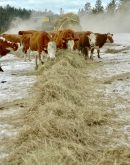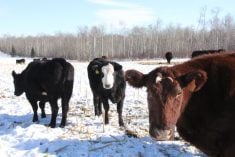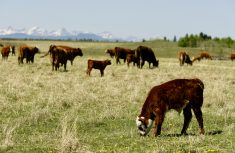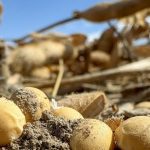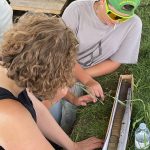Dr. Gabriel Ribeiro walks onto the stage at the Saskatchewan Beef Industry Conference following four other researchers in the Saskatchewan beef industry. This is part of the Cattle College portion of the conference, where researchers educate conference attendees on the work they’ve been doing in the industry.
Ribeiro is an assistant professor and the Saskatchewan Beef Industry Chair at the University of Saskatchewan. His research focuses on improving forage efficiency in cattle and looking into the environmental effects of cattle.
At the conference, Ribeiro presents on four interconnected studies he’s been working on regarding forage-efficient cattle.
Read Also

Canadian Beef Check-Off Agency reports on investments and activities
The check-off agency’s work behind the scenes is what ensures cattle check-off dollars are invested wisely, accounted for transparently and deliver measurable value back to producers and importers.
“Our hypothesis is that cattle with greater digestible fibre intake would have positive RFI (residual feed intake) because they eat more,” Ribeiro says.
Research
Ribeiro’s research comprises four connected studies.
“They were all designed as one big study divided into those four studies, and they use the same animals,” he says in an interview.

Study one took place over 56 days and consisted of a high forage-based diet in Grow Safe bunks, which are designed to measure the feed intake and behaviour of cattle. The diet for the heifers contained 70 per cent silage and 30 per cent concentrate.
Study two measured methane emissions of the cattle. They were fed the same diet as the previous study, but these cattle were housed in one feedlot pen.
The third study took place over two blocks of 49 days. The heifers were divided into two treatment groups: one had a high intake of digestible neutral detergent fibre (NDF), which is the most common measurement of fibre while analyzing animal feed. The other had a low intake of digestible NDF. The heifers were housed in individual stalls.
The fourth study used the same 16 heifers. However, they were fed four different diets: 100 per cent grass hay, 100 per cent alfalfa hay, 90 per cent barley grain with 10 per cent alfalfa hay, and 90 per cent barley grain with 10 per cent grass hay.
“The main objective was to try to understand what physiological parameters and what traits in cattle are making them better at eating and digesting that fibre. And then based on that, we wanted to see if we could select for that and after selecting for that try to understand what makes them better,” Ribeiro says.
The research started two years ago and is wrapping up now.
Ribeiro says they started by picking their heifers from calves recently weaned from the cow-calf herd.
From there, they monitored the heifers eating. The automated feed bunks they used, GrowSafe, were able to read what the animals were eating and how much they were eating. They weighed the heifers every week and took fecal samples to see how they were digesting the fibre.
From that data, they picked out the top eight heifers and the bottom eight heifers and compared them.
“We did a bunch of studies looking at how they digested the fibre, also the feeding behaviour. We looked at the weight gains. We looked at methane production. So, we looked at a lot of parameters to try to really understand what makes them so different,” Ribeiro says.
This research was conducted at the Livestock and Forage Centre of Excellence, located south of Saskatoon.
Methane
Ribeiro spent time in his studies researching methane emissions as well.
For Ribeiro’s research, he says they did methane mapping and used technology called a GreenFeed system, which measures the emissions of methane and other gases.
Ribeiro says their goal was to investigate the relationship between fibre digestibility and methane emissions.
“Environmental sustainability has become more and more important,” he says. “The government is interested in finding solutions so we can reduce the impact of livestock on the environment. So, we added a portion of this work, one of the objectives, to look at if there is any difference on methane production.”
The government’s interest in methane reductions is evident in a news release from December 2023, where Environment and Climate Change Canada released a draft protocol under Canada’s Greenhouse Gas Offset Credit System to incentivize producers to reduce methane emissions.
Fibre digestibility
Ribeiro says the fibre digestibility results are the most exciting parts of the research.
He says the animals that were more efficient at digesting fibre ate the fastest. In addition, the animals that spent more time ruminating, or chewing their cud, put more time into breaking down the fibre.
Ribeiro says these results will be beneficial for producers to select more efficient cattle.
“By selecting those heifers that can eat and digest fibre more efficiently, we think there’s an opportunity to reduce the cost of production and profitability,” he says. “So I think for the producer itself, that’s super important.”
He says selecting for more efficient cattle means during times of drought, cattle will still perform well, despite lower feed quality.
This issue is very prevalent in the Canadian beef industry currently as many places across the Prairies grapple with a multi-year drought that doesn’t show signs of letting up.
“I think having animals that are more adapted to the environment and animals that can use better, lower-quality forages and fibre, that has a huge benefit — not just to the beef producer, but to the environment as a whole.”
When it comes to methane emissions, Ribeiro says they found animals that were more efficient at digesting fibre were also producing less methane.
“It was a bit surprising because usually, the more fibre you digest and you break down, you should have more methane production associated with that. But we didn’t see that, we saw the opposite,” Ribeiro says.
He says this is good news for the industry because producers selecting for efficiency will also select for animals that produce less methane.
“I think it gave us a little bit more energy to continue to pursue this line of research, because we think it is quite valuable.”
Future
Now that the research is done and the results are in, Ribeiro and his team have been compiling data and are in the process of getting it published.
As for the future of this study, Ribeiro is forging ahead.
“It was a first study with a smaller number of animals. We want to take it larger, generate more phenotypes,” he says. “So we can go deeper into the genetic markers associated with that improved ability to eat and digest fibre.”
He says the goal is to generate genetic markers so in the future producers can purchase the tool based on those genetic markers.
“We still have quite a bit of work to get there. And hopefully, we’ll be able to continue to work on that.”






